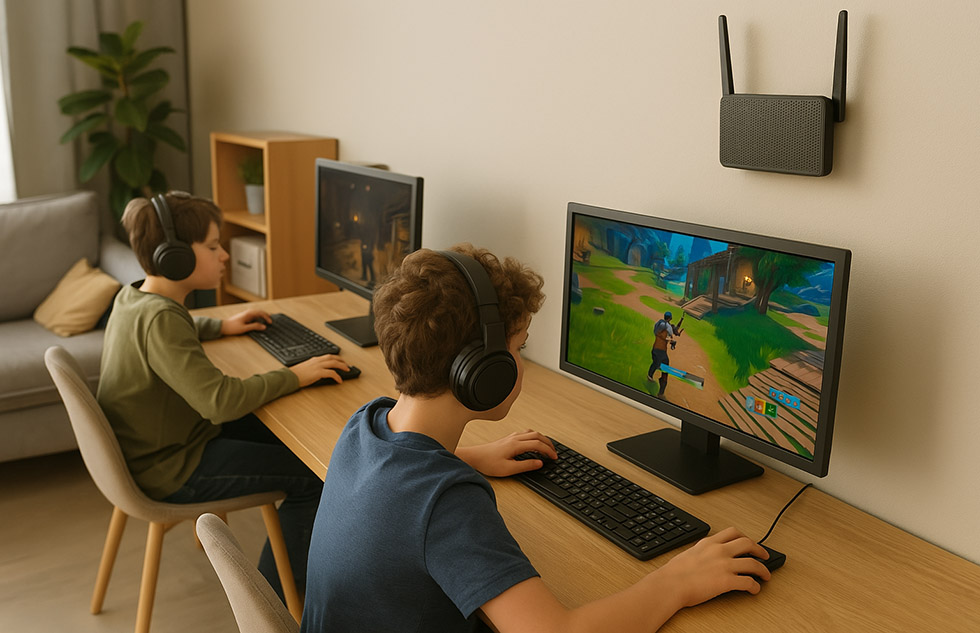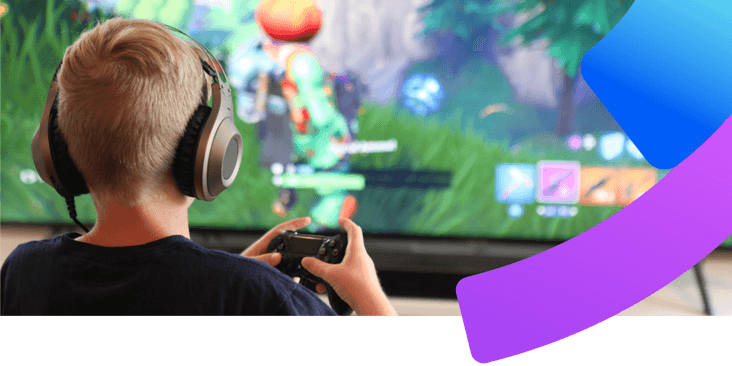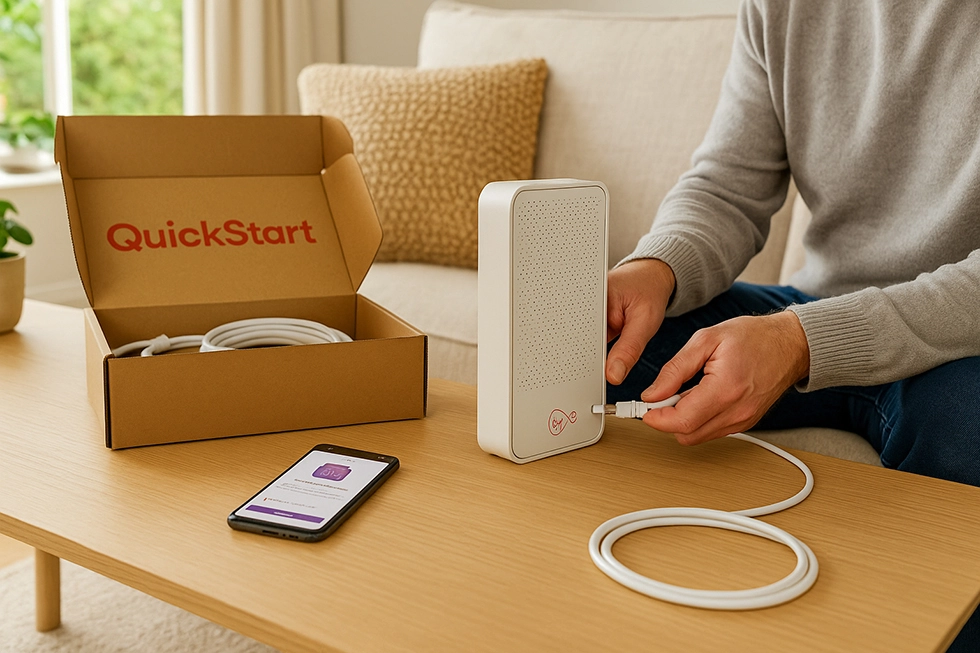Gaming broadband – Explained & Best UK Deals Reviewed
Smooth gaming online depends less on download speeds and more on how quickly data travels between you and the game servers.
The key is low latency, consistent performance, and a connection that doesn’t lag when someone else at home is streaming, downloading updates, or joining a video call.

In the UK, the best gaming broadband options usually come from full fibre providers because fibre lines significantly reduce latency and handle congestion far better than older copper networks. Cable broadband can deliver very fast download speeds, but performance for gaming depends on how well your local area handles latency during busy hours. A growing number of alternative fibre networks are also targeting gamers with packages that emphasise low ping and faster upload speeds.
So who actually offers the best broadband plans for gaming in the UK right now? To make it simpler, we’ve reviewed the main providers and selected the deals that stand out for online play.
Below you’ll find our top picks — covering both big names and newer full fibre providers — so you can compare offers side by side and choose the one that works best for your setup.
BT
| Provider | Why it’s selected |
|---|---|
| BT Full Fibre | Consistently low latency. Wi-Fi 6 or better router. Optional mesh add-ons. 2.5GbE WAN/LAN . |
| Community Fibre | Full fibre with very low ping’ Symmetric speeds. Wi-Fi 6/6E router. Mesh pods available. 2.5GbE ports. |
| Hyperoptic | Full fibre with low latency Symmetrical speeds. Wi-Fi 6 router mesh add-ons. 2.5GbE available. |
| Zen Internet | Consistency and low latency suited to gaming & streaming Wi-Fi 6 router and 2.5GbE. Optional mesh kits. |
| Virgin Media | Good for huge game updates & patches. Wi-Fi 6/6E hubs with 2.5GbE port on newer packages. Optional mesh pods for coverage. |
What really matters for gaming broadband
When it comes to gaming, raw speed is only part of the equation. What really shapes your experience is how fast your commands reach the game server and come back — in technical terms, latency, jitter, and packet loss.
Latency (measured in milliseconds) is the delay your keyboard or controller input takes to register in the game. Jitter is variability in that delay; you don’t want your ping jumping around mid-match. Packet loss means data gets dropped en route, causing stutters or disconnections.
Because of that, connections that are consistent and low-delay beat sheer throughput for multiplayer gaming. Full fibre (FTTP) connections tend to offer the most consistent low latency, while cable and wireless options may spike under load. And availability is very postcode-dependent — some streets are already covered by full fibre, others are still waiting.
How much speed do you actually need?
Is 100 Mbps enough?
Yes — for the gameplay itself, 100 Mbps is more than enough. Modern online matches often require only a few megabits per second. The caveat: if your household also streams, downloads big patches or runs multiple devices, you’ll want some headroom. The key is that you don’t need a monster speed just to play.
Is 500 Mbps too much?
For playing in matches, it’s overkill. But if you’re downloading new AAA games, streaming in 4K, and hosting content simultaneously, 500 Mbps gives breathing room. It doesn’t lower your ping, but it cuts waiting times and lets everyone in the house use bandwidth generously.
Is 900 Mbps good for gaming?
It’s excellent if your priority is fast updates and pushing large amounts of data. The gameplay latency will settle around the same as a 200–300 Mbps connection, assuming the routing and network conditions are similar. In effect, it makes everything else run quicker, but won’t make your in-match response times magically faster.
Best connection types for gaming
- Full fibre (FTTP)
This is the gold standard. Because the whole path is optical fibre, you avoid many of the noise and interference issues that plague older copper or hybrid lines. The upload speeds are often generous too. - Cable (DOCSIS, e.g. Virgin Media)
Cable can offer very high speeds, but you may see more spikes under stress or local congestion. It can work well when fibre isn’t available, especially if you pair it with a quality router or use modem-only mode. - Fixed wireless / 5G / 4G home
These are fallback options. They can offer decent speeds, but consistency is harder. When cell towers are busy, latency and jitter tend to fluctuate.
Which UK providers are excellent options for gaming
BT and Openreach-based ISPs
Where full fibre is available, BT and ISPs that use the Openreach fibre infrastructure often give solid latency performance. Many gamers prefer them because routing to game servers tends to be reliable, especially where the local backhaul is strong.
Sky / Plusnet / Vodafone on fibre
They often share the same fibre routes as BT in many areas. The difference comes down to router, policy, price, and how well their network handles peak time. Many gamers choose based on fine margins and customer service.
Community Fibre
An altnet pushing full fibre in some inner London areas. They market very low ping and promise minimal jitter — if you live in their zone, it’s one to test.
Hyperoptic
Focused on multi-dwelling units and urban areas, Hyperoptic offers gigabit-class fibre. Great for fast downloads, though the in-game performance will depend on routing and home setup.
Virgin Media
In areas where fibre isn’t yet built, Virgin’s cable network can still deliver very high speeds. But the key is to control the local network (good router, quality settings) to avoid latency spikes under load.
YouFibre / CityFibre ISPs
These are local fibre networks and their performance often comes down to how well they manage routing and latency for your specific area. They can be excellent if their infrastructure is well implemented.
Grain
Grain markets “Gigafast Gaming” packages with full fibre, uptime, and low latency built in — with features like a static IP included. This shows how niche ISPs are trying to tailor packages to gamers.
Zen
Zen emphasises low latency over its full fibre network, making gaming a priority in its marketing.
Picking the best broadband for your area
- Start with a postcode check. See who offers FTTP, cable, or local fibre.
- Look for local latency reports — forums, speed testers, BQM (Big Quality Monitoring) sites.
- Ignore hype speeds. Focus on what routes look good in your area. For instance, one street’s 900 Mbps might have worse latency than another’s 200 Mbps fibre because of backhaul differences.
- Check how well the provider handles traffic priority or whether they throttle or shape certain usages (some providers manage P2P, streaming, etc differently).
Console notes: Xbox Series X and PS5 performance tips
For both, the recommended setup is similar:
- Use a wired (Ethernet) connection if you can. It removes Wi-Fi jitter.
- Ensure NAT type is open or at least moderate so matchmaking works well.
- Enable QoS or traffic prioritisation so your console isn’t competing with big downloads from other devices.
- When large updates arrive, schedule them for off-peak hours or pause them while gaming.
Even with these settings, in-game performance will follow your network quality — not tricked by fast download numbers.
Finding cheaper gaming broadband without compromising latency
If you can’t stretch to premium plans:
- A lower-tier full fibre plan (say 100–160 Mbps) is often better for gaming than a higher speed on a less consistent technology.
- Avoid cheap bundles that overload shared infrastructure. Congested nodes or poorly managed lines harm latency.
- Use a capable router with SQM or traffic shaping to keep your gaming traffic smooth even when others in the house are updating or streaming.
Router and setup tweaks to reduce lag
- Prefer wired connections for consoles/PCs.
- Enable Smart Queue Management (SQM) or Quality of Service (QoS) on your router so downloads don’t interrupt your gaming latency.
- Use modem-only or bridge mode on ISPs that force combined router/hub — this gives you full control.
- Schedule big downloads away from game times.
- For Wi-Fi, use the latest standards (Wi-Fi 6/6E/7). They don’t reduce in-game ping if your backhaul is weak, but they reduce contention inside your home.
Answering your specific questions
- What broadband do I need for gaming?
Ideally full fibre FTTP. If that’s unavailable, cable is your next bet — but ensure your local network isn’t overloaded. - Is 100 Mbps a good speed for gaming?
More than enough for gameplay. The question is whether your home usage environment (downloads, streaming) will fit around it. - Is 500 Mbps overkill for gaming?
Overkill for play, but very useful for fast updates, multiple users, and future proofing. - Is 900 Mbps good for gaming?
Excellent for data-heavy usage, though in-match latency will match what your network allows, not speed alone. - Is BT better than Virgin for gaming?
If you have fibre availability, BT (or any good Openreach-based ISP in your area) may match or beat Virgin in latency. In places where fibre is absent, Virgin often offers superior download performance. Real result depends on routing and infrastructure in your area. - Is 900 Mbps good for gaming?
As above: plenty of headroom for downloads, but gameplay is limited by consistency and latency, not just top speed. - Who is the best provider for gaming?
The best choice is the one offering full fibre in your area with consistent low latency and good routing to peer with game servers. Use local user experience and latency tests, not just national reviews.
Final thoughts
Gaming broadband isn’t about chasing big numbers — it’s about consistency, routing, and low delay. A modest full fibre plan with good latency will often beat a blazing fast plan on a less dependable network. Use your postcode, test your latency, and pick the provider whose real-world performance you can trust. Then pair it with a good router and smart setup, and you’ll get smoother play, fewer lag spikes, and happier matches.

